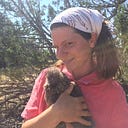Beyond the Power Nap
My little secret to maximizing focus, creativity and energy throughout the day.
I quit drinking coffee several months ago. While I miss my morning routine (heat the kettle, pour water through the cone), it was nice to feel my body gradually release the tension I hadn’t even realized I carried. No more headaches! I used to get headaches that I had no idea could have been related to caffeine, and I don’t miss those.
One problem though, was that since quitting coffee my bedtime kept inching earlier. The days were getting longer, but I was struggling to keep my eyes open past seven o’clock! My morning coffee routine, it turns out, worked as a zeitgeber, literally a “time-giver.” That’s an external cue that realigns our circadian rhythms with the sun’s 24-hour cycle. My circadian rhythm is 23 hours compared to the average 24.2, so I’m an hour ahead. Without adequate zeitgebers, I would lay there for an hour in the morning waiting for a respectable time to jump up and start my day, and then I would fall asleep at parties.
If you’re familiar with the four chronotypes you’re going to tell me I’m a Lion. Until recently I would have said you were right, I was an off-the charts Lion. Lions go to bed early and get up early. They have tons of energy in the morning, get a lot done in early in the day, and slowly wind down throughout the afternoon and evening until they’re zombies by about ten pm. I have never been able to stay awake until ten, but I would be the life of any party that happened at six in the morning.
Experts advise Lions to take light power naps early in the afternoon to help sync back up with the solar day. That’s not enough for me. Being a Super Lion, I need to take siestas for an hour to an hour and a half. That allows me to keep functioning past sunset.
The three other chronotypes are Wolves, Bears, and Dolphins. Wolves are most alert around the time others are going to bed, and they like to sleep in late. Bears have even levels of low-key energy throughout the day. Dolphins are light sleepers who keep erratic schedules and have bursts of energy at random times.
Here’s something you probably didn’t know. There are more than four chronotypes. I had to use some powerful Google-Fu to find this out. In November 2020, researchers at Institute of Medicine of RUDN University studied 2,000 people and made a case for six distinct variations. They didn’t assign animal mascots to the variations, so maybe that’s why the news hasn’t taken off yet.
The official canon of sleep science had previously recognized two chronotypes based on alertness levels throughout the day — Morning Types (Larks) and Evening Types (Owls). It turned out that only 37% of the participants in this new study found themselves in those categories.
Based on the results, they’ve added Daytime Type, Daytime Sleepy Type, Highly Active Type, and Moderately Active Type. These would roughly correspond to the four popular chronotype characterizations as:
Morning Type (13%) = Lion
Evening Type (24%) = Wolf
Daytime Type (15%) = Bear/Dolphin
Highly Active Type (9%) = Dolphin
Moderately Active Type (16%) = Dolphin/Bear
Daytime Sleepy Type (18%) = Lion/Dolphin
What’s interesting about this study is that the participants self-selected their classifications by answering a single question. If I had been asked to choose a category when I was still a coffee drinker, when I used to rely on sugar and caffeine to power through the afternoons and crash as soon as the sun went down, I would have picked Morning Type.
I wonder how many other people are Daytime Sleepies but wouldn’t know it because they either don’t have time for afternoon naps or don’t allow themselves to indulge. We are the second most common type, and our representation probably would have been even higher if this study had been conducted in a culture where afternoon siestas are the norm.
I wonder how many other people take chronotype quizzes and still wonder whether they’re more bear or dolphin?
Not just allowing myself to take long naps, but making it a priority, has made a huge difference in my creativity and productivity. I can focus for longer periods, whereas before, mornings were the only times I could get things done. Early morning is my top-functioning time period, and now I get two early mornings per day.
I made a 24-hour clock to visualize what parts of my day are best for what. Red is creativity, orange is focus, yellow is eating, green is physical activity, light blue indicates breaks during focus times, dark blue is relaxation, and purple is sleep.

I think it’s important to understand how your energy ebbs and flows throughout your circadian rhythm and use zeitgebers to realign your days with the rest of the world. It’s probably important enough to complicate the established system of chronotypes and add two more mascots. I’m going to take a crack at it, but first, it’s time for my nap.
References
Putilov, Arcady A. et al. “Single-Item Chronotyping (SIC), a Method to Self-Assess Diurnal Types by Using 6 Simple Charts.” Personality and Individual Differences 168 110353. Web.
